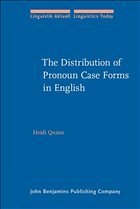Nicht lieferbar

The Distribution of Pronoun Case Forms in English
Versandkostenfrei!
Nicht lieferbar
Main description:This book offers an in-depth analysis of Modern English pronoun case. The author examines case trends in a wide range of syntactic constructions and concludes that case variation is confined to strong pronoun contexts. Data from a survey of 90 speakers provide new insights into the distributional differences between strong 1sg and non-1sg case forms and reveal systematic case variation within the speech of individuals as well as across speakers. The empirical findings suggest that morphological case is best treated as a PF phenomenon conditioned by semantic, syntactic, and pho...
Main description:
This book offers an in-depth analysis of Modern English pronoun case. The author examines case trends in a wide range of syntactic constructions and concludes that case variation is confined to strong pronoun contexts. Data from a survey of 90 speakers provide new insights into the distributional differences between strong 1sg and non-1sg case forms and reveal systematic case variation within the speech of individuals as well as across speakers. The empirical findings suggest that morphological case is best treated as a PF phenomenon conditioned by semantic, syntactic, and phonological factors. In order to capture the way in which these linguistic factors interact to produce the pronoun case patterns exhibited by individual speakers, the author introduces a novel constraint-based approach to morphological case. Current case trends are also considered in a wider historical context and are related to a change in the licensing of structural arguments.
Table of contents:
- Acknowledgements
- Key to abbreviations
- Introduction
- 1. The history of the English case system
- 2. Formal approaches to case and the three case constraints
- 3. Case and the weak/strong distinction in the English pronoun system
- 4. The empirical survey
- 5. The survey results
- 6. Relative Positional Coding and the Invariant Strong Form constraints
- 7. Modelling the interaction of the constraints
- 8. The distribution of personal pronoun forms in other strong pronoun contexts
- 9. The distribution of wh-pronoun forms in Modern English
- 10. Speculations and conclusions
- References
- Name index
- Subject index
This book offers an in-depth analysis of Modern English pronoun case. The author examines case trends in a wide range of syntactic constructions and concludes that case variation is confined to strong pronoun contexts. Data from a survey of 90 speakers provide new insights into the distributional differences between strong 1sg and non-1sg case forms and reveal systematic case variation within the speech of individuals as well as across speakers. The empirical findings suggest that morphological case is best treated as a PF phenomenon conditioned by semantic, syntactic, and phonological factors. In order to capture the way in which these linguistic factors interact to produce the pronoun case patterns exhibited by individual speakers, the author introduces a novel constraint-based approach to morphological case. Current case trends are also considered in a wider historical context and are related to a change in the licensing of structural arguments.
Table of contents:
- Acknowledgements
- Key to abbreviations
- Introduction
- 1. The history of the English case system
- 2. Formal approaches to case and the three case constraints
- 3. Case and the weak/strong distinction in the English pronoun system
- 4. The empirical survey
- 5. The survey results
- 6. Relative Positional Coding and the Invariant Strong Form constraints
- 7. Modelling the interaction of the constraints
- 8. The distribution of personal pronoun forms in other strong pronoun contexts
- 9. The distribution of wh-pronoun forms in Modern English
- 10. Speculations and conclusions
- References
- Name index
- Subject index




